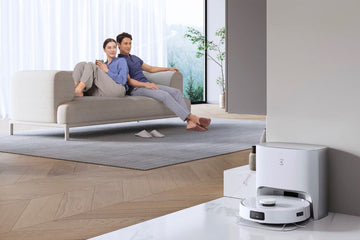Let’s face it—our homes are carrying a lot these days.
They’re no longer just where we sleep or eat. They’re where we hustle through Zoom calls, decompress after long days, catch our breath, raise kids, sip tea, fold laundry, scroll endlessly, and—somewhere in the chaos—try to relax. With everything your space holds for you, it’s no wonder it sometimes feels like it’s missing something… a sense of peace, maybe? A sense of grounding.
Feeling grounded at home isn’t about a complete redesign or shopping spree. It’s about intentionally creating an environment that supports your energy, your routines, and your calm. The good news? You don’t need to hire an interior designer or knock down any walls to make your home feel more like a sanctuary and less like a to-do list.
Here are five beautifully simple, practical ways to make your home feel more grounded—no construction required.
1. Start with the senses
When we talk about “feeling grounded,” we’re really talking about returning to the body. To the breath. To what we can see, touch, smell, and hear. The quickest way to ground your space is to stimulate the senses gently and intentionally.
Sight: Opt for warm, earthy tones in decor—think beiges, terracottas, soft greens, muted golds. Avoid harsh overhead lighting in favor of soft, layered light. Something like a 3 in 1 Wireless Bedside Lamp, with warm dimmable settings, can give you flexibility depending on the time of day or mood.
Smell: Introduce calming natural scents—lavender, cedarwood, eucalyptus, or sandalwood—via essential oil rollers, diffusers, or even simmer pots on the stove.
Touch: Use textures that comfort you. A woven throw, a wooden tray, a ceramic mug. Even small accessories like a linen napkin or cotton hand towel can anchor you in the present moment.
Engaging your senses intentionally helps your brain associate “home” with ease, rather than just tasks.
2. Declutter, then layer with meaning
We’ve heard it a thousand times: declutter your space, declutter your mind. But what often gets missed is that once the clutter’s gone, we need to fill our homes back up—not with stuff, but with soul.
Take a weekend morning to go room by room. Don’t just toss the junk—ask yourself: What do I want to feel in this room? What supports that? Once you’ve cleared out what doesn’t belong, reintroduce items that hold meaning. Maybe it’s a framed photo from a trip you loved, a vase from your grandmother, or a handmade souvenir.
Or maybe it’s something as simple as a piece of art. A softly abstract piece like the Canvas Earth Painting Living Room Poster can create a visual pause—a grounding presence that doesn’t scream for attention but still says I belong here.
3. Create grounding zones throughout your home
You don’t need an entire meditation room to create moments of calm. Instead, think in small zones. Where can you set up mini sanctuaries?
In the kitchen, maybe it’s a designated tea or coffee corner with a few mugs, a tray, and a plant.
In the entryway, a small bowl for your keys and a wall hook can instantly say, “You’re home now. Set it down.”
By the bed, a nightstand with a soft light, a book, and a water cup signals that this is your place to rest.
In the living room, a cozy chair near natural light becomes your slow-morning reading nook.
Each zone doesn’t have to be perfect. It just has to serve a feeling.
4. Let nature in (even in tiny ways)
Nature is the original grounding force. But if you don’t have time to hike every weekend or live by a forest (wouldn’t that be lovely?), you can still bring the feeling of nature inside.
Plants. Even just one leafy friend can shift the vibe of a room. Snake plants, pothos, and ZZ plants are great low-maintenance starters.
Natural materials. Lean into wood, clay, stone, rattan, linen, and cotton in your furniture and accessories. They don’t need to be fancy—just real.
Earth-inspired art and color palettes. Artworks with abstract landscapes or neutral tones invite a sense of stillness and space.
Even keeping a ceramic jar on your desk with some dried eucalyptus can offer a moment of breath in the middle of a hectic day.
5. Simplify your digital + smart home experience
Grounding doesn’t mean going off-grid—it means using tech that supports your peace, not hijacks it.
Instead of shouting across the house to turn off the lights or pulling curtains manually every day, consider small upgrades that simplify your routine. A product like the Bluetooth Smart Drawstring Curtain Motor automates your environment in a soft, subtle way—letting light in gradually when you need it and giving you privacy with a tap.
Likewise, consider adding a soft ambient light that transitions with the time of day or motion-sensor lighting for midnight bathroom trips. These little touches minimize friction and help your home respond to you—without overwhelming your senses.
Final Thoughts: Make Space for the Life You Want
Grounding your home isn’t a one-time project. It’s a gentle practice—an ongoing relationship with the space you live in. It’s about asking what supports you today, not what impresses others. It’s about creating a home that reflects the life you want to live, not just the one you’re managing to survive.
You don’t need a perfect aesthetic. You don’t need every room to be magazine-worthy.
You just need your home to feel like a breath of fresh air in the middle of a busy world.
So go light a candle. Rearrange a shelf. Let some light in. Ground yourself.
And let your space become the quiet support system you didn’t know you needed.








